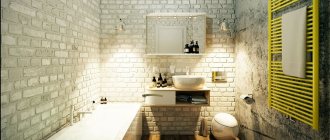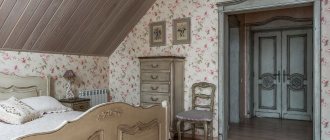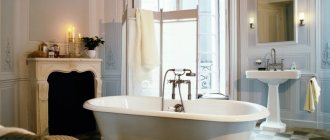Features of Japanese style in the interior
To better understand how a Japanese-style interior differs, just familiarize yourself with its main components:
- Minimalism and pragmatism. The Japanese value space. It is believed that the abundance of “extra” things and decorations negatively affects the energy of the house. Therefore, the apartment should contain only the most important things, what is necessary;
- Functionality. This point is a continuation of the first, since maintaining free space directly depends on the convenience and versatility of the selected furniture. Japanese interior style presupposes the presence of all kinds of transformable items that can solve several problems at once and allow you to save useful space;
- Close to nature. When creating an interior in the Japanese style, you should use exclusively natural materials: for finishing the room, in furniture upholstery, and in textile design;
- Mobility. Historically, the Japanese have been forced to live in small apartments, in which frequent rearrangements are very important. The same room can serve different purposes. For example, the living room or dining room, where it is customary to spend time during the day, turns into a bedroom closer to night. For such metamorphoses to be real, special attention should be paid to the choice of all components of the interior.
Japanese style: environmental friendliness comes first
The laconicism and minimalism that is characteristic of the Japanese style is based on the use of natural materials. In previous centuries, only readily available materials were used to decorate their houses.
This includes:
- mat;
- bamboo;
- stone tiles;
- cane;
- tree;
- rice paper;
- natural silk.
Beautiful combination of materials
Currently, the rules for arrangement are not so strict. But the use of synthetic materials is also limited. We are talking about linoleum, plastic and the like.
But artificial materials are not completely prohibited when decorating a Japanese interior..
Advice If it is not possible to use, for example, natural wood, it can be replaced with a high-quality laminate. A similar approach is necessary when replacing natural stone with imitation, natural silk with fabric that looks very similar to it.
Natural wood in design
Shoji partitions
Partitions between rooms, made in Japanese style, give the apartment originality and emphasize the direction of the design. They are mobile and lightweight, as they are made from rice paper or bamboo.
This seemingly strange and impractical approach actually has a historical practical basis. Frequent earthquakes in the land of the rising sun taught the Japanese to build houses that easily survive difficult circumstances. And if necessary, they can even be easily replaced.
Nowadays, blindly following these traditions is not necessary. Manufacturers offer more practical models: sliding doors with Japanese patterns, matching prints on panels, etc.
Sliding wardrobe with sakura pattern
Screens are an optional but very stylish element of modern Japanese design. If you need to fence off any area of the room, then you won’t find a better replacement.
Furniture for contemplating the inner world
Do you want to relax and unwind at home, enjoy peace and rejuvenate? Japanese design promotes relaxation from the bustle of the city, noise and showdowns.
Closeness to nature and earth in the interpretation of oriental design implies the use of solid furniture made from natural materials. Squat objects should have stable, low, strong legs and a simple shape.
There cannot be tall cabinets in the interior. And the furniture itself should not be too much.
There shouldn't be a lot of furniture here
Wood is a typical material for production. Valuable species can be replaced with pine needles. Even if all the furniture is very expensive, it should not “scream” about it. A connoisseur of quality things will always be able to understand that the thing is not simple. Another characteristic feature is the absence of carvings on wooden surfaces and plastic inserts.
Purchasing furnishings for decorating an apartment in Japanese style can be done in two ways:
- Authentic Japanese items with history.
- Collections currently on the market.
Furniture fittings should also not be flashy . Forged elements, made very carefully, are acceptable as a means of emphasizing the texture of the base material.
The highlight of a Japanese-style interior can be antique items.
What interior items can we not do without in strict Japanese design?
You can't do without a bed with low legs
Among them should be:
- beds with low legs (they can be replaced with mattresses);
- squat tables for traditional tea drinking;
- special mats or pillows near the table;
- cabinets with sliding doors, etc.
Engawa or traditional window?
Initially, Japanese houses were equipped with special canopies called “engawa”. Such structures protected from rain flows and provided shade from too bright sunlight.
There should be a lot of windows
According to the tradition of the East, there should be a lot of windows. As curtains in houses with Japanese-style interiors, rectangular panels of fabric that move apart are now used. They may be equipped with an electric drive for control.
The prints on the curtains must strictly follow the canons of Japanese style:
- sakura branches;
- bamboo shoots;
- bright birds;
- Japanese landscapes;
- hieroglyphs;
- fans;
- geisha in traditional attire.
Roller and Roman blinds are used for shading. The smoother and more laconic the curtains, the more accurately the style matches.
Curtains for shading
When decorating in Japanese style, curtain models with frills, draperies, and complex accessories are not used.
Walls
When decorating walls in a Japanese interior, as well as other surfaces, it is important to follow the rule of using natural materials. A combination of several materials looks impressive. What to choose?
The following materials are suitable:
- stone;
- plaster;
- paper wallpaper;
- sisal;
- rattan;
- tree.
Stone for wall decoration
There is very little furniture in Japanese home design and it is low. Its quantity and location should be taken into account when selecting material for walls.
Advice: There should not be many pictures on the walls.
Wallpaper
Oriental motifs on wallpaper in apartment interiors influence the perception of the entire room. They serve as a backdrop for furniture, create the necessary accents and emphasize authenticity.
Most often, wallpaper (and photo wallpaper) is used when decorating a bedroom. It is advisable to choose a light and fairly neutral background in pastel colors. To emphasize the originality of the design, companion colors are added.
Wall decoration with photo wallpaper
Wallpaper can be combined with other natural materials:
- tree;
- bamboo, etc.
If plain wallpaper is preferred, then one wall can be decorated with photo wallpaper depicting, for example, a sakura branch. Such wallpaper can create the effect of a photograph, a view of Mount Fuji or other typical Japanese landscapes.
Typical Japanese landscape
National motifs on the walls emphasize the style of the interior, adding notes of unusualness and uniqueness. This allows you to create an interior that is unlike others.
Materials and finishing
Ceiling
A classic version of a Japanese-style ceiling is a plain stretch fabric. It is desirable that the surface of the stretch ceiling be matte, since a glossy sheen is contrary to the rules of this design direction. An analogue of a suspended ceiling can be frosted glass slabs with moderate lighting.
Walls
In traditional Japanese rooms, wooden frames covered with rice paper are often found on the walls, however, when partially stylizing the room, it is enough to use wallpaper that matches the design. The walls of a Japanese-style apartment can also be draped with thin natural fabrics, the color of which should be as close as possible to the shade of the floor covering.
Floor
The ideal material for a Japanese-style floor would be natural light wood. If this option seems too expensive to you, you can always resort to a budget solution to the issue. Bamboo laminate is an excellent replacement for natural wood, and its appearance will no less successfully emphasize the theme of the chosen interior. While observing the main rules of the Japanese style in decorating a room, one should not forget about the placement of wicker carpet products (tatami). It can be placed under a chest of drawers or a tea table.
Selection of decorative elements
The use of decor in Japanese interior style is minimal. It is for this reason that it will always catch your eye. This means that it should be selected carefully.
Important! The main rule of wall decoration is to use only one item per wall.
If you look closely at traditional Japanese interiors, you can see wooden frames on the walls filled with plain rice paper. They can be the size of an entire wall and often serve as interior partitions. And they can also form an element of decoration.
Partitions made of rice paper and wooden frames for a Japanese-style room Source v9-design.com.ua
Decoration also follows the rule of a philosophical design idea. When covering the floor with mats, you need to make sure that their corners do not touch. According to Japanese beliefs, if corners are connected together, it brings misfortune to the house. Rugs are laid in a checkerboard pattern or in rows. Any way that expresses order will create the perfect Japanese setting.
Textile design involves the use of fabrics made from natural threads. Therefore, the Japanese style in the interior is characterized by cotton, linen, suede, leather coverings or textiles. Matting or plain canvas fabric is especially often used.
Types of decor:
- seat cushions on the floor;
- bamboo mats laid on the floor;
- wall panel;
- rectangular lattice lanterns;
- netsuke figures;
- large-scale application of hieroglyphs;
- rice paper floor lamps;
- clay tea utensil;
- Bonsai tree in a pot;
- sakura in a floor pot;
- elegant vases;
- engravings;
- fans;
- samurai paraphernalia (daggers, armor, belts);
- caskets;
- ikebana;
- origami products.
The interior is decorated with floor lanterns, figurines on shelves, panels, panels with plant patterns Source vitrum-novo.ru
The panel can be woven or handmade. The fact that the fabric is made by hand is clearly visible from its characteristic texture. It gives the interior naturalness and originality. This is where ornate contours and elements depicted on the panel are allowed.
Curtains on the windows are also used in Japanese interior style. Only they are not draped like curtains, but are modestly hung in one strip. Such curtains are also called panel curtains - they create an imitation of a perfectly flat surface, a panel.
Roller blinds and blinds with elegant floral or fairy-tale patterns are also suitable. These products should also be made from natural materials - bamboo, wood, thick rice paper, matting. It is not necessary for the shade of the curtains to blend with the color of the walls, ceiling or floor. You can choose darker shades, but in the same or contrasting colors.
Color design
Japanese style in the interior is laconicism, calmness and balance. If you are a fan of colorful design with a dominance of flashy colors, then this style may not be for you... After all, the Japanese interior is dominated by cream, beige, light gray, gray-green, white and wood shades. To create minimal contrast in a room, you can use red and black.
Bamboo in Japanese painting
Bamboo in Japanese painting
“Isn’t the path to enlightenment in the rustling of bamboo... Dogen
In Japan, as in most other East Asian countries, bamboo was usually depicted on paper. As a symbol, it carries all the same meanings as in China. Japanese art has been heavily influenced by traditional Chinese art for centuries, and as a result, many Japanese bamboo scrolls are very similar to Chinese ones.
Japanese ink painting flourished during the Muromachi and Azuchi-Momoyama periods. The Azuchi-Momoyama era put an end to feudal fragmentation in Japan.
Tesshu Tokusai. Orchids, Bamboo, Rose Hips and Stones After his return to Japan, Tokusai introduced the genre to other Zen monks such as Gyokuen Bonpo (1325–1388), another famous artist. Zen masters depicted scenes from everyday life, birds, cherry branches of sakura, wild orchids, bamboo. The Beginning of Zen Art in Japan
Gyokuen Bompo (c. 1347 - 1420) Kakemono: Orchids, Bamboo, and Thorn - Right Panel
Bamboo was a popular theme in Zen art and ukiyo-e in Japan, as well as in various styles of Japanese painting until the beginning of the Edo period (1603-1868). Some of the most famous Japanese artists such as Hasagawa Tohaku, Katsushika Hokusai and Ando Hiroshige created dramatic and colorful bamboo paintings.
Until the advent of ukiyo-e painting in the Edo period, when the art became easily accessible to the average person, Chinese-style paintings were painted almost exclusively for the Japanese court and military elite. Images of bamboo were one of the most common themes that artists worked on to satisfy the demands of the elite. The Kano school is characterized by very bright paintings of bamboo on a gold background.
Kano Tanyu (1602-1674), Tigers in the Bamboo Grove Kano Tanyu. The sixth Zen patriarch at the moment of enlightenment.
This small image of Kanō Tanyou, done in a few strokes of light ink, is a reminiscence of a legendary early thirteenth-century scroll by the famous Chinese artist Liang Kai (now in the Tokyo National Museum). It illustrates the Zen parable of Hui-neng (638-713), the sixth patriarch of Zen (Chan in Chinese), who suddenly received enlightenment when he began cutting bamboo for firewood.
The Hasegawa school represented a different approach to depictions in general and bamboo in particular. The school was founded by Hasegawa Tohaku (1539-1610). Hasegawa develops his own style, which had its origins in the Kano school. His style is characterized by greater decorativeness and flatness compared to the style of the Kano school.
Door panel by artist Hasegawa Tohaku with a crane in a bamboo grove. Tohaku was famous for his Chinese-style door panel paintings, which often depicted animals (especially monkeys) surrounded by bamboo.
Hasegawa Tohaku. Crane among bamboo
Hasegawa Tahaku. Pine and bamboo
Hasegawa Tanhaku. Birds and flowers
Ogata Korin 1658, Kyoto - June 2, 1716) - Japanese artist. He managed to develop his own special artistic and decorative style. Founder of the Rimpa style.
Ogata Korin. Bamboo and plum tree.
Nanga School Artists of the Nanga School painted their works mainly in ink. In their monochrome works, Nangi artists sought to follow the principles and aesthetics of Chinese Wenrenhua literati artists. The work of the Edo period artist Gion Nankai (1677-1751) “Bamboo in a Window on a Rainy Day” 「竹窗雨日」図 is expressive. Gion Nankaya is a representative of the Nanga school, or otherwise bunjing, painting of writers.
Gion Nankai "Bamboo in the window on a rainy day"
The top two-thirds of this scroll is occupied by an image of bamboo, its leaves drooping under heavy rain. Below, young bamboo shoots against a peculiarly shaped boulder, dots of black moss that seem to float around its contours. At the age of twenty-four, Gion Nankaya was dismissed from his position as a Confucian scholar for "extravagance." It was restored only ten years later. But his years in exile contributed to his fame as a pioneer of the Japanese literati movement. The clarity of Nankai's brushwork in this work demonstrates his careful study of Chinese painting textbooks.
Tani Buncho. Landscape and bamboo. 1804 Tani Buncho (Japanese 谷 文晁 Tani Buncho, also Tani Masayasu Japanese 谷 正安; 1763 - 1841) - Japanese artist and poet, also a representative of the Nanga school.
"The Sparrow and the Bamboo" by Ando Hiroshige (1797-1858). This print depicts a sparrow, a symbol of happiness—another common motif in Japanese art.
In Japan, sparrows often decorate many household items and art, and they are often depicted in bamboo or with ears of rice.
Ando Hirsige. Sparrow among the bamboo
Bamboo silhouettes are also popular images of bamboo. For example, on Sukoshi shoji folding screens. These screens can be found in many Japanese homes. "Bamboo" by the eighteenth-century Japanese artist Kikuya Kihei.
Kikuya Kihei. Bamboo silhouette
Bamboo in the four seasons. Tosa Mitsunobu (1434-1525)
"Bamboo and the Moon" by Nagasawa Roztsa (nasagswa roztsa) (1754 ~ 1799)
"Bamboo and the Moon" by Nagasawa Roztsa (nasagswa roztsa) (1754 ~ 1799)
Bamboo is also popular among representatives of the Rimpa school.
Sakai Hoitsu. Sakai Hoitsu. Three friends. Pine, cherry and bamboo. Japanese poets wrote about bamboo, putting symbolic meaning into the image of the plant. The transience of time, the brevity of its time allotted for love, for example, was symbolized by the short length of bamboo.
Sangi Hitoshi
In the asaji field
In the field asaji - Small bamboo in the field. No matter how much I hid, my heart became full. Why do I love her so much?!
In the work of Fujishima Takeji (藤島武二, 1867-1943), features of romanticism and impressionism and adherence to the Western style in Japanese painting can be traced. In recent years he has been influenced by the Art Nouveau style.
Bamboo in the wind, Fujishima Takeji
Contemporary painting.
Shiro Kasamatsu. Bamboo grove in spring. 1954
Master Konoshima Okoku worked in the Nihonga style. He depicted the winter moon against the backdrop of a bamboo grove.
Konoshima Okoku. winter moon
Ink and paint on silk, right screen, 167x372 cm. Kyoto City Museum of Art.
Konoshima Okoku. Winter moon. Left screen
Deiryu (Deiryu 1895–1954). Bamboo. (Detail)
Deiryu Kutsu (Kanshu Sojun) (1895-1954) Hiroshi. Bamboo
In the twentieth century, artists of the Shin-hang movement continued to create prints on traditional themes. The artist Hiroshi Yoshida, who depicted a bamboo grove (1939), belongs to the Shin Hanga school.
Lighting
The Japanese-style interior welcomes full multi-level lighting, which is adjusted depending on the time of day. The colors of the lamps should not stand out radically against the background of the calm design of the room. And also an important feature of lighting is the use of diffused rather than directional light sources. Therefore, in such interiors you can often find lampshades made of rice paper and bamboo.
Lamps and sconces located in different corners of the room are designed to change the perception of the interior and illuminate specific objects or areas. This visual zoning technique is very important for open-plan rooms.
Kitchen and dining room interior
The kitchen and dining room in Japan are one room divided into two zones. Food is prepared in the “kitchen” area, so all the necessary equipment is installed there. Since the Japanese prefer minimalism and functionality, their kitchens have no place for massive appliances and many cabinets. When decorating a kitchen in the Japanese style, built-in kitchen appliances and one or two spacious kitchen cabinets made of wood are used.
In the eating area there is a table with chairs. Like all other furniture, the kitchen table should be low, and mats can be used instead of chairs. During meals, the table is covered with a plain tablecloth or mat.
The main color for decorating a kitchen can be either a light or dark shade. As decorative elements in this room, designers recommend using floor vases, sophisticated plain sets, wall panels and rice paper lampshades.
IMPORTANT: Traditional Japanese curtains are not hung in the kitchen. Instead, light white or beige cotton curtains are used.
Dishes
In everyday life, the Japanese use ceramic dishes made in simple rectangular, round or triangular shapes. For everyday meals, plain dishes are used, and on holidays the table is set with sets.
A Japanese-style kitchen must have the following utensils:
- Van - deep, but small dishes with a lid for rice and first courses;
- Khati - shallow, wide serving bowls for main courses;
- Chawan - tea bowls;
- Katacuti - bowls with a spout for sauces;
- Tyatsu - bowls on a foot for side dishes;
- Dobin – teapots;
- Bon - round or square trays.
Japanese style furniture
The right choice of furniture is a prerequisite for creating a harmonious interior in the Japanese style.
As a rule, style furniture is characterized by: - simple geometry; — lack of artistic decorative details on the surface of the furniture; - stockiness.
To create a full-fledged Japanese style in the interior, it is enough to place in the room a sliding wardrobe with window doors and a low table for holding tea ceremonies. Japanese minimalism can save you from the need to purchase many pieces of furniture that are used to furnish “ordinary” apartments. In rooms stylized in Japanese style, there are no bulky chests of drawers, armchairs, wardrobes or dressing tables. Bedside furniture is characterized by simplicity and small dimensions. The upholstery of upholstered furniture should be natural and durable (leather, suede, cotton). To store clothes, you can use not only a built-in wardrobe, but also small Japanese-style chests, which are considered an integral part of the interior by Easterners.
Pay attention to Japanese types of furniture: • tatami (mats made of reed rods); • futon (cotton mattress); • byobu (partition, screen); • tansu (chest of drawers).
Design principles and traditions
Interiors decorated in Japanese style are both similar and different from each other. What they have in common is a sense of space, the absence of any unnecessary elements and contrast, and what is individual about them is the combination of colors, decorative elements and features of the division of functional zones. This ethnic style is one of the few styles that combine minimalism, functionality and a strong personality.
The principles and traditions of interior design in Japan have been formed over centuries and have remained virtually unchanged. And the main ones in this style are the following 8 principles:
- Everything superfluous is superfluous. A lot of free space, a minimum of furniture and decorative “trinkets” and the presence in the house of only necessary things are the most important principles of the Japanese style.
- Smooth surfaces only. Floors, walls, furniture and household appliances should have smooth, shiny surfaces. Moreover, you should not put decorative decorations on them, cover them with napkins or place things.
- Only light natural materials. Rice paper, bamboo, light wood, ceramics are materials that the Japanese traditionally use for interior decoration.
- Harmony is achieved through contrasts. Yin and Yang, fire and water, black and white - the balance of opposites is one of the basic principles of Japanese philosophy. This principle is also reflected in the design of housing, so this ethnic style is characterized by a combination of contrasting colors.
- The more light the better. Large windows, light walls, sliding doors with white frosted glass, light-diffusing akari lamps are constant attributes of the Japanese home, designed to make the room bright and visually add space to it.
- Minimum walls and doors. The Japanese style is characterized by dividing space into functional zones using screens, paper partitions, lighting or contrasting colors. In traditional Japanese houses there were no separate rooms at all - the entire space was divided into zones exclusively by paper partitions.
- Live and dried plants are the best interior decorations. Traditional decorations of the Japanese interior include ikebana, bonsai, ceramic figurines, tableware for the tea ceremony, vases, fans and akari. Moreover, other decorations, in addition to bonsai and ikebana, should be present in the setting to a minimum.
- Life on the floor. In Japanese homes, all the furniture is low, and most often chairs, armchairs and beds have no legs at all. Residents of the “Land of the Rising Sun” are accustomed to sitting and sleeping on the floor, so large soft chairs and sofas with many pillows will not fit into the decor of an apartment in this ethnic style.
Details and decor
As already mentioned, a small number of decorative elements and accessories are welcome in the Japanese interior style. The most authentic additions could be:
- Floor vases;
- Branches of cherry blossoms;
- Japanese fans;
- Ikebana;
- Samurai daggers;
- Images of hieroglyphs;
- Sliding screens for zoning space;
- Caskets;
- Netsuke figures;
- Dwarf bonsai trees.
When decorating a Japanese interior, you must remember that everything in it is aimed at creating an atmosphere of calm and relaxation.
Japan: the beginning of the beginning
By plunging into the fundamentals of Japanese design, we discover the philosophy of the East, the perception of the world by people living so far from us, their traditions and mentality. For an Eastern person, thoughts and actions are important, but not petty vanity. All these requirements are transferred to housing decorated in Japanese style.
Apartment in Japanese minimalism
Harmony does not need an abundance of furniture and accessories, bright decor and pretentious flashy expensive things. Japanese interior is the simple beauty of ordinary things, order and neatness in the arrangement of objects.
Who will like and suit this style? Thoughtful, calm people who value order in the house and the aesthetics of the surrounding interior.
Formation of style
As such, the Japanese style of decorating residential premises dates back to the distant 16th-17th centuries. Several centuries later, it is still in demand and popular.
There are many elements and accessories to choose from
The following factors influenced its formation:
- frequent earthquakes;
- traditions of the people;
- small amount of minerals;
- densely populated Japan;
- climate.
Since the 16th century, there has been a tendency in Japan to furnish houses with taste and in the spirit of tradition. Luxury has given way to higher values. The Western approach to the arrangement of apartments and their decoration has not taken root in the land of the rising sun.
It is important to maintain full style
The peculiarities of the country's territorial location, frequent earthquakes and climate have left their mark. In areas with an unstable seismological situation, quite often people had to rebuild houses after destruction. The easily assembled structures of the external walls and the absence of internal ones made it possible to simply restore the building.
Open plan
Spaciousness should be felt even in a small home. Economical use of free space requires a small amount of furniture, and even more so accessories. According to ancient Japanese traditions, there are no ordinary-shaped interior walls and doors in the house.
A little bit of Japan for the bedroom
At the same time, the allocation of zones is maintained using various techniques:
- screens and other partitions;
- lighting;
- level floors, etc.
Interior today: are there any differences?
Several centuries later, the design style of houses in the Land of the Rising Sun has undergone some changes.
This style features an open floor plan
It reflected the events taking place in the world:
- technical progress;
- wars, including World War II;
- scientific achievements.
All this has led to new opportunities for housing design and construction. Concrete, materials imitating wild stone, wood, etc. began to be widely used in construction.
But even the development of science and technology could not change the foundations of style and the desire for community with nature.
Stylish design for an apartment
Interior design in Japanese style - photo
Japanese style in the living room interior:
Japanese style kitchen interior:
Japanese style in the bedroom interior:
Japanese style bathroom interior:
More photos:
Where to use Japanese style?
- Japanese style will look good in an apartment with an open plan, where you can do without walls. And screens can be used as partitions.
Remember that of course there will be no sound insulation with such beauty.
However, if you love silence and privacy, then you can organize a Japanese interior in a small space - it will look even more comfortable.
- For Europeans, the Japanese style is most conveniently used in the design of a bedroom or living room - only these rooms can be laconic.
The Legend of the Painted Mice
A long time ago, in the 14th century, a young Japanese artist named Seshu angered the monastery authorities. Because he was drawing during religion lessons, he was tied to a tree and forced to meditate. But Seshu decided to do what he loved: he drew little mice on the sand with his toe. Yes, so masterfully that they immediately came to life, gnawed through the ropes with which Seshu was tied to the tree, and freed their creator.
Tags: Creativity, master classes, drawing, sumi-e
Living room
Japanese living room design has become very popular. There are several reasons for this. This decor looks original and at the same time ascetic, and the interior has a special charm. Friends of home owners who have decorated their living room in a Japanese style will love the minimalist design of the room in the spirit of modern Japan.
People in such a room always feel comfortable, and Japanese decoration can be done even in a small room.
The seating area is the main element of a Japanese-style living room. It is formed from small sofas or comfortable armchairs, where the owners of the house and their guests can sit.
A good find is to install a small table at which you can drink tea. Scatter pillows around the table: they will help create an atmosphere conducive to relaxation.
Japanese style room design, photo
Instead of bookshelves, install niches in the walls. Ikebana, original figurines and vases are placed in them to emphasize the Japanese focus. Numerous trinkets are out of place here.
Advice. To liven things up, install a screen or decorate window openings with curtains with Japanese patterns.
But don't go overboard in trying to accurately recreate the Japanese style. It is difficult for European residents to get used to the fact that all objects are very low and located as close to the floor as possible.
Try to adapt the interior to your living conditions. After all, the main thing is convenience.
Apartment design in Japanese style, photo
Original furniture
Japanese furniture consists of low, but very comfortable, functional designs of cabinets, chests of drawers, tables and beds.
Related article: Ideal apartment design in Amsterdam: Dutch beauty and brightness
The peculiarity of Japanese furniture is absolutely smooth facades, without any decoration.
Tansu - traditional Japanese furniture will replace traditional European furniture sets and numerous wall shelves. Tansu is a chest of drawers on wheels and a massive lid, which can simultaneously serve as a storage place for numerous things, a bench, and even a ladder (each step is a spacious chest drawer).
The main principles of creating Japanese decor
The people of Japan have their own philosophy. The main rules are peace and a harmonious combination of everything. Taking this into account, the Japanese organize their living space.
Japanese-style interiors are best created in houses with an open plan. The fewer walls, the better.
All details of Japanese decor must obey the main principle - a minimum set of elements, no frills. For this reason, it is not worth decorating the room with sweet trinkets and vignettes that Russian people love so much.
A minimum number of pieces of furniture, extremely strict forms, low height. Carpets are replaced with small mats. This is where Japanese design comes into its own. The Japanese have this tradition: they place all the things they need in everyday life on the floor.
Interior design in Japanese style, photo
But Japanese residents are well aware of convenience and strive to make the environment comfortable. There is a lot of technology in the home of any resident of this country: it makes life easier, because with smart appliances and modern equipment, doing housework becomes easier. Technical devices are hidden from view in drawers and special compartments.
Niches are equipped for storing clothes and other accessories: they are hidden in the wall. Furniture that has transformation properties also copes well with this task.
Due to the fact that Japanese houses are usually small, like apartments in our country, this style implies multifunctional filling of space. Using screens and light-weight partitions, the room is divided into functional zones. There are also Japanese partitions and areas for relaxation and business activities.
Japanese-style bedroom interior, photo
The Japanese believe that a person can relax as much as possible only by feeling close to nature. Taking this into account, materials of natural origin are used in finishing.
The color scheme of Japanese decor is light shades. They set you up for relaxation and help you find peace after a hard day. The most common are soft pink and the entire pastel palette of shades. To achieve contrast, use white and chocolate colors; universal black is also popular.
Interior decoration in Japanese style includes plants in flower pots.
Japanese style room, photo
Interior design features
Features of Japanese interior design include:
- abundant use of natural elements. They should not only consist of paintings or the use of small trees. In a country house, it is best to arrange a garden, which will be its natural extension. The windows should look out onto beautiful natural places: a lawn, a pond, or trees. In an urban environment, natural decorative elements are suitable: an aquarium, bamboo, low trees;
- It is best to use light colors: beige, sand, white;
- furniture is used squat without backs and shelves;
- natural materials are used in decoration: wood, bamboo, straw, or substitutes are used;
- the presence of minimalism;
- Bamboo partitions are used to divide the room into rooms.
Living room decoration
The Japanese-style living room interior has minimalist features. Furniture does not play a major role here, so only the most necessary items are used. Its distinctive features are low legs, squatness, and geometricity.
There are no carvings, curved legs or pretentiousness - the Japanese style recognizes only laconic lines.
The living room will look more lively if there are flowers in it, placed in graceful vases or ikebana. Since the main feature of the Japanese style is the presence of a large amount of free space, you will have to give up shelves and niches to achieve maximum effect.
Kitchen decoration
The principles of finishing and designing the kitchen remain the same. The furniture used is wooden, geometric in shape. For a small kitchen, a simple design set made of metal or wood, a kitchen table with a light glass top, is perfect.
Much attention should be paid to tableware: teapots made of clay or cast iron, small cups, sushi items and other Japanese-style utensils will go well with the overall design.
As decoration, you can use vases made of glass, porcelain or ceramics, paintings or engravings depicting nature, samurai or geisha.
Bedroom decoration
The interior of a Japanese-style bedroom should be soft and comfortable. The walls and ceiling can be finished in soothing colors: beige or sand tone. For lighting, sconces, floor lamps or spotlights are used.
The amount of furniture and decor should be minimized. A low bed with straight legs must be placed in the middle of the room, and Japanese-style rugs will only add drama. You can also create a dressing area using a partition. And paintings, vases, plants will help create an oriental atmosphere.
Bathroom decoration
Bathroom design should be done in neutral colors using simple lines and shapes. Ceramic tiles imitating wood or straw are used to finish the floors and walls. Tiles on the walls can be replaced with decor, borders or panels.
For a Japanese bathroom interior, a suspended ceiling painted with moisture-resistant paint is best suited.
The decor can be very diverse:
- soap dish;
- bowl-shaped sink;
- towel hooks;
- bathroom.
Bedroom
[ads2] Considering the conditions prevailing in the apartments of our Russian citizens, it is almost impossible to recreate an authentic Japanese bedroom. But it is quite possible to make the interior as close to Japanese as possible.
The characteristic features of the Japanese bedroom are minimalism, high mobility and naturalness , this also applies to color design and materials used for decoration.
A Japanese-style bedroom is decorated with materials of natural origin. Bamboo, textiles, rice paper, wood - all this looks beautiful and natural. It is better to give preference to soft tones. But keep in mind that the flooring should be slightly darker than the color of the walls and ceiling .
Japanese style ceiling, photo
Try to create natural light in the room. Lamps located on the ceiling serve as sources of artificial light. It is better to make the ceiling suspended.
The beds are of low height, and it is even better to sleep on a special elevated mattress.
There are no large wardrobes in a bedroom with Japanese decor. Things are stored in cabinets or chests of drawers built into the walls. Sliding wardrobes with sandblasted hieroglyphs are often used. Cabinets are often located hidden and are not conspicuous.
Bedding and other household necessities are stored in niches. The niches close, and things become invisible to the eye, while at the same time they do not clutter up the space.
Paintings in Japanese style, photos
It is acceptable to place small tables in the bedroom or place bedside tables on both sides of the bed. But they should be of a simple shape, without any decorative details.
Read about how to decorate a living room interior in a modern classic style: all the secrets and subtleties, design secrets, lots of photos.
See examples of living room furniture in the Art Nouveau style here.
A selection of photos of beautiful apartments in a modern style is in the article at:
Unity with nature
The use of natural materials allows you to create a peaceful, calm atmosphere of harmony and happiness - the basis of the Japanese interior.
Screens made of bamboo or rice paper will help define the functional areas of the open space. The walls and floors are decorated with wooden panels.
Only light natural materials are used in decoration - fabrics made of linen or silk, airy structures made of rice paper.











